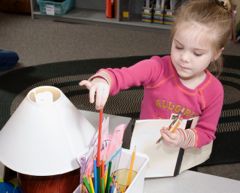Launching Daily 5 in Kindergarten, Part 3
Join Our Community
Access this resource now. Get up to three resources every month for free.
Choose from thousands of articles, lessons, guides, videos, and printables.
To best prepare students for the launch of Read to Self in kindergarten, we spend the first week focused on what it means to be independent. Then during Week 2, we introduce good-fit books and the Three Ways to Read a Book. This provides students with the necessary background knowledge to support a successful launch of Read to Self in Week 3. 
Week 3 in Kindergarten—Week 3 is where the launch of Daily 5 in kindergarten blends nicely with the launch of Daily 5 in other grade levels. We follow the 10 Steps to Independence and build stamina to become better readers. The biggest difference? Focus lessons in kindergarten are very brief and therefore we typically add only two behaviors to the I-chart at a time.
Step 1: Identify what is to be taught—In a whole-group setting, the teacher writes a big I on chart paper and then writes "Read to Self" at the top. The teacher tells the children that the I stands for "Independence" and asks if they remember what it means. Then the teacher says, “Boys and girls, today we are going to learn to Read to Self.”
Step 2: Set a purpose and create a sense of urgency—To keep this lesson brief and focused, we provide the purpose of the task to students. “We learn to Read to Self because it helps us be better readers. We all want to be better readers, don’t we?" (Yes) "We also Read to Self because it is fun! Reading helps us learn new things and use our imaginations!”
Step 3: Record desired behaviors on an I-chart—Teacher records the desirable behaviors on the I-chart in front of the students and briefly explains each one. With younger students, we list and explain only the first two behaviors in the first sitting.
“Close your eyes and think about what it would look like and sound like in here if everyone was reading to themselves. One thing you would see is students reading the whole time." (Teacher writes "Read the whole time" on the I-chart.) "This means that you would have your eyes on the book and be reading the entire time. Another thing you would see is everyone staying in one spot." (Teacher writes "Stay in one spot.") "This means that once you sit down, you would not get up and move around, but you would stay in that spot the whole time. While you are Reading to Self, what am I doing? I am working with students.” (Teacher writes "Working with students" on the teacher side of the I-chart.)
Step 4: Model most-desirable behaviors—Choose a student to model the behaviors listed on the I-chart. The teacher reads the behaviors on the student side of the I-chart and then asks the class if the student is modeling them correctly. Then the teacher asks the essential question, “Boys and girls, if ____ continues to do these things, will he become a better reader?”
Step 5: Model least-desirable behaviors—If you launch Read to Self in the first few days of kindergarten, we do not recommend having someone model the least desirable behaviors, because it can confuse children about expectations. However, if you are launching after you have taught expected classroom behaviors, this step is a powerful way to communicate Read to Self expectations to students. Be sure after a student models it the wrong way to have the same student turn his behavior around and model it the right way. (See more on p. 41 of The Daily 5 second edition.)
Step 6: Place students around the room—The first few days to a week, the teacher places students around the room, reminding them to pay close attention to where they work best. This should move quickly for the best result. We usually place three or four students at a time, and we start with the students we think will have the strongest stamina.
Step 7: Practice and build stamina—Children practice and build stamina. This could be 30 seconds to a minute on the first day.
Step 8: Stay out of the way—Teacher trusts students and stays out of the way while students build stamina. This helps students learn independence and prevents them from relying on the teacher to keep them on task.
Step 9: Use quiet signal to bring students back to gathering space—Use a quiet signal to call children over to the gathering area. This should be reviewed and practiced ahead of time.
Step 10: Conduct a group check-in; ask, “How did it go?”—Older students typically use a four-point check-in. This can be used with kindergartners, or to simplify it, you may wish to have children give a thumbs-up for "good" and a thumbs-sideways for "needs work." We do not use thumbs-down because children are called back to the gathering area before they have a chance to do poorly with a behavior. After check-in, the teacher uses the stamina chart to graph the time achieved.
If stamina is broken after a very short time, you may wish to sound the chimes and quietly tell children to leave their things where they are and come to the gathering area. Revisit the I-chart, graph stamina, and send the children a few at a time back to their spots to practice again.
The second day of the launch looks much like the first, only more behaviors are added to the chart. This time the teacher adds Get started right away, Read quietly, and Build stamina. The 10 Steps are followed just as in Day 1.
The third day of the launch in kindergarten, we typically revisit the I-chart (Step 3), may add "Ignore distractions" and "Build bathroom stamina," and then move to placing students around the room (Step 6).
Subsequent days resemble Day 3 until the class has achieved the desired stamina. Depending on class success, the teacher may choose to model again or refine behaviors. Typically on Day 4 or 5, the teacher will let the students who are ready choose a successful spot, with the goal of all students choosing their reading locations by the end of the launch.








